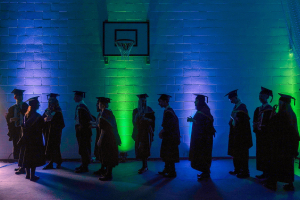As a result of the large-scale sanctions imposed over the military actions in Ukraine, the Russian economy has been hit with severe negative supply shocks: restrictions on procurement and payments for raw material imports, supplies and components and on the delivery of finished products, as well as delays in payments. The latter situation includes both exports and supplies to the domestic market, which is affected by the fact that production and trade chains connect importing companies and the subsidiaries of foreign investors with Russian suppliers. In the wake of persistent supply shocks, the emerging economic downturn may be compared in its depth with the crises of the 1990s, but the recovery trajectory this time is expected to be significantly longer in time.
High tech production typically involves global production chains with hundreds or even thousands of production, transport, financial, and service companies cooperating across the globe. The removal of just a few links from this chain, especially those closest to the final stage of production and delivery, can paralyse the operation of the entire chain. That is why even a high degree of localisation of production could be useless if the missing components are unique and cannot be easily replaced with the products of another manufacturer. This creates risks for the mechanical engineering and electronics industries most of all.
The foreign trade and financial constraints, which apply to a wide range of goods and services and span broad business and financial activities, render the Russian economy increasingly closed off from the rest of the world. This will reduce the share of imports and exports in Russia's GDP, with GDP itself declining in parallel. This further means that Russia’s GDP, over the medium term, will decrease much more in reserve currency terms (yuan, dollar, etc.) than in real terms (that is, there will be a decline in the real effective exchange rate). Conversely, the gap between GDP calculated by purchasing power parity and nominal GDP will grow. Also, in the short term, the combination of high prices for Russian commodity exports (even adjusted for price discounts on global market prices), the forced suspension of foreign currency purchases under the fiscal rule, and the ongoing foreign currency restrictions may well lead to a temporary strengthening of the real effective exchange rate of the ruble.
The restrictions will also result in decreases in technological and engineering sophistication and in labour productivity in the sanctioned industries. Industries that rely on the most advanced foreign technologies and those with highly digitalised business processes risk being hit harder than others.
Relative prices are expected to change over the medium term. First, prices for goods will increase more relative to prices for services (except for imported services). Relative prices will increase the most for goods with high import components in their cost. Second, there will be a surge in prices for investment goods relative to labour prices (wages, income). This will come as a result of lower labour productivity in the broader economy and a drop in total factor productivity (TFP), to the effect that real wages will decline more than GDP, and their share in GDP will fall. Third, the reduction in output will be lower than the GDP drop due to falling production efficiency. Concurrently, the demand for labour will increase for the same reason, and a relative replacement of capital with labour will occur.
Under this scenario, potential GDP will decline along with real GDP. Output potential will drop through two key channels:
1) due to declining physical volumes of exports, driven by sanctions and restrictions, which means a direct deduction from GDP
2) due to a partial loss of value added following a switch to alternative importers and forced import substitution.
The loss of potential GDP will hold back a subsequent recovery on the back of demand factors, causing a significant delay in the return of GDP to the 2021 level.
As regards future growth rates of potential GDP, it is essentially a question of whether the development gap between the Russian economy and OECD countries, which has expanded in the course of the downturn, will subsequently decline or expand. The answer to this question depends on multiple factors, the most important of which are technological in nature and relate to the capability of the Russian economy to import or to quickly replicate foreign technology, as well as to create its own technologies which reduce the technological gap and can be applied in mass production.
The structural transformation of the Russian economy in the face of sustained external restrictions will come with technological regression across multiple industries. The transformation is expected to evolve in the following directions and stages (link in Russian):
Stage 1: many well-established technological, production, and supply chains are disrupted. The affected companies are primarily those importing (directly or through suppliers of raw materials) critical production components, even if they account for only a small share of costs. Supply disruption and discontinuation pose risks to the financial position and operations of all companies throughout the production chain, which undermines access to financing even from Russian sources. This is a stage in which previously accumulated stocks of raw materials and production components will be a key factor. Exporting companies and component suppliers in the production chain are affected to a lesser extent thanks to previously created financial cushions built on exports in 2021 and the smaller scale of export restrictions at this stage.
The adaptation strategy at this stage is to maintain current operability and involves drawing on reserves (including financial reserves) and the search for alternative foreign buyers/suppliers and transport routes. Absent reserves and the ability to quickly restructure, a sharp decline in production occurs, affecting the entire production chain. At the same time, contagion risks to other production chains are on the rise. This is partially due to the growing uncertainty in the broader economy and companies’ increased credit risks, which undermine any incentives to lend to them.
Technologically, the first stage involves a gradual worsening of the problems due to shortages of spare parts and the inability to maintain foreign equipment. This leads to increased equipment failures and an overall loss of technical efficiency.
Stage 2: initial adjustment of companies and production chains to the new operating conditions. As reserves run out, it will become clear which production chains will remain, albeit in a modified form, and which will be gone. The key factor at play here will be the ability to quickly switch to alternative foreign and domestic suppliers. The downturn will show its secondary fallout at this stage, too, which will have an additional impact on the economy through demand, the labour market, and incomes.
For Russian suppliers, the key constraint on the expansion of replacement production will be production capacity and the extent to which expansion depends on imports. For this reason, a sharp increase in the production of replacement products is unlikely at this stage. This is a critical difference from a typical cyclical downturn caused by a temporary decline in demand while aggregate supply is unchanged. At the same time, repair and service enterprises will build growth momentum if they are able to provide troubleshooting and maintain production lines in operating condition.
As regards supplies to be established from alternative foreign suppliers to counter continuing restrictions, we will see increased importance for small intermediary foreign trade companies and ‘shuttle’ enterprises (especially in the consumer segment). However, the small purchase volumes and the complexity of logistics will drive the cost of such imports upwards and the total replacement of traditional suppliers will be impossible. Overall, the decline in the technological sophistication of the Russian economy is expected to continue at this stage as material and technical facilities age and are replaced with less productive substitutes.
At the second stage, employment is expected to drop more dramatically in the worst hit industries, as well as in those failing to adjust. This will be accompanied by growing demand for labour from small and medium businesses (including in the shadow sector) that service foreign trade and provide repair and maintenance. That said, consumer services are highly likely to record a drop in employment as the structure of the consumer basket and of relative prices tilts towards goods.
The decline in output and gross value added will chiefly occur during the first and second stages, approximately through the end of 2022. The oil and gas industry will continue to decline into 2023 and possibly thereafter.
Stage 3: ‘reverse industrialisation’, or industrialisation based on the development of less advanced technologies. This stage, which may last several years, will see the implementation of investment projects resulting in the partial substitution of previously imported and currently unavailable technologies and industries. The production of machinery and technologies will grow, but their technological level is likely to be lower. Importantly, the effect of small scale (due to the impossibility of mass production for the limited domestic market) will lead to higher costs for such equipment and technologies for consumers, compared to those that are state-of-the-art but unavailable.
In terms of technical and economic efficiency, the machinery created will therefore be inferior to that in current use. In particular, this will affect the level of digitalisation of equipment and business processes in areas where the technological reversal is most pronounced. At the same time, employment in import substituting industries will rise, and production will grow ahead of other industries, to the effect that the production sector will gain a higher share in the economy.
Production will become less environmentally friendly, which is another important implication. Emissions and waste per unit will increase as less resource-efficient technologies are increasingly used.
The lower productivity and efficiency of machinery and technologies will require more employees in industries relying on machinery and technologies, as well as in the industries that service them. This will bring the overall unemployment rate down, although with few implications for real wages. Wage growth will thus lag behind production growth, and labour will become cheaper relative to capital (fixed assets).
Stage 4: with the restructuring complete, a new equilibrium is struck, and development is driven by a new, inferior technological base. In terms of economic structure, the share of manufacturing and business services in the Russian economy will grow in the medium term. The share of investment sectors will also expand on the back of a diminishing share of consumer sectors, and the sectoral structure of employment will change in the same manner. Considering the demographic situation and economic needs for more labour, the unemployment rate is expected to be low.
The final stage will see a gradual and long-term return to the previous level of technological sophistication. Additionally, local technological breakthroughs are not impossible.
Following the shift of the economy towards alternative foreign trade partners and import substitution with other possible types of intermediate and investment products, subsequent economic developments, including potential growth rates, will be determined by the following factors:
- The intensity of the external restrictions and changes in them.
- The extent of the technological lag behind other countries. The greater the lag, the easier it will be, all other things being equal, to reproduce advanced technologies locally.
- Opportunities for large-scale exports of products with high value added, and active forays into new markets. The greater the economy of scale, the more efficient production will be, and the more growth opportunities will exist.
- The public to the private sector ratio in the economy. If private business initiative is constrained, excessive regulation of the economy will hold back potential growth rates, whereas expanding business initiative and deregulation will support growth.
- A drop in the share of rent payments in budget revenues and a possible rise in general taxes to offset it – which will become a constraint on business activity.
- A possible increase in the share of public consumption in GDP due to either additional tax increases or the redistribution of budget expenditures. Such a structural shift would be unfavourable for potential growth rates.
- The role and place of foreign companies and investments in Russia. It is critical to restore the appeal of direct and financial investments in Russia.
- Human capital development and the availability of social elevators, compliance with meritocratic principles in management.
- The preservation and development of economic and financial institutions and infrastructure.
One or another combination of these factors could drive potential GDP growth either higher or lower than that over the last decade (estimated at slightly under 2%).
The success of the adjustment and the subsequent structural transformation of the economy depends above all on entrepreneurial activity. Therefore, the strategic task of the state is to support it in every way. This will involve large-scale economic liberalisation, a radical reduction of state regulation and control, and a lower tax burden (except rent taxes).
.jpeg)






